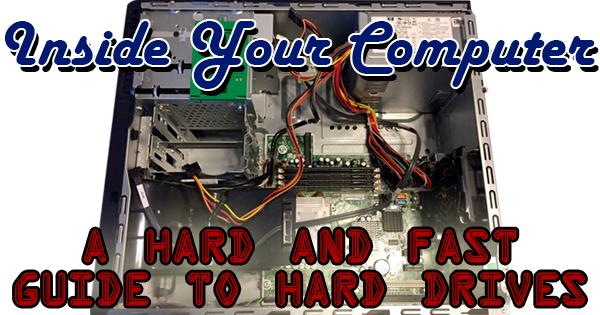
In our first installment of our “Inside Your Computer” series, we introduced you to the central processing unit (CPU). I liken the CPU to the “brain” of the computer, as this is where all the calculations are completed that allow the P.C. to perform whatever is asked of it. If you missed that post, click here. Last week was all about short term memory. Random access memory (RAM) acts as a go between for the CPU and hard drive to access and launch programs and information as directed by the user. For the skinny on RAM’s short term memory, click here. That brings us to today’s subject: the hard drive. If the CPU is the brain of the computer, you can really get technical and say that the hard drive is the hippocampus of the brain where short term memory gets turned into long term memory. Hey, I’m not a doctor, I’m a computer guy, so don’t e-mail me if I got that wrong! Let’s move on to something I know more about, hard drives!
The hard drive is where data gets stored permanently. Your operating system (i.e. Windows 10) lives on the hard drive. Files are saved to the hard drive. Programs are installed to the hard drive. Photos transferred from your phone to the computer are stored on the hard drive. You get the picture. Unlike RAM, the hard drive is non-volatile, meaning information is not erased from the hard drive when the computer is shut down. Currently, there are two types of hard drives available for purchase today: hard disk drives (HDD) and solid state drives (SSD). I recently wrote “The ABCs of HDDs and SSDs” which gives much more detailed information about the two flavors than I’m going to delve into today. Click here if you’d like to read it. For this post’s purposes, I’ll mention that HDDs are the older, more common technology, with a lower price tag as compared to the new kid on the block, the SSD. You’ll find a SSD to be much faster and more responsive than the traditional HDD, but at a much higher price per amount of storage.
Hard drives are always labeled according to their available storage space. In today’s marketplace, you’ll see them in either gigabytes (GB) or terabytes (TB). To put that into perspective, one gigabyte is enough storage for approximately 300 photos. One terabyte is adequate for 300,000. You might see an advertisement for a computer with a 500GB drive. If so, you can assume that the computer has a 500GB hard disk drive. A computer with a solid state drive would be clearly marked as having an SSD, as in a 250GB SSD. Very high end computers may come with both a SSD and a HDD, as in a 2TB HDD plus 240GB SSD. The operating system and programs would be installed to the SSD to allow programs to load faster, while data would be saved to the HDD. One other note on HDDs: as mentioned earlier, hard disk drives are older technology. As part of this technology, HDDs are mechanical, with spinning platters inside. Sometimes, you’ll see a HDD listed as a 5400 RPM while another computer may have a 7200 RPM drive. A higher RPM (revolutions per minute) indicates a faster hard drive.
I’ve often said that the hard drive is the most important component in your system. Without an operating system, programs, and data, your computer is basically a paperweight. When purchasing a computer, invest in a system that has a HDD with more storage space than you think you’ll ever need. SSDs are the future, but add greatly to the cost of a system. You can always add another HDD or external hard drive down the road for little cost, so don’t worry about buying the largest SSD possible. One last point: remember that the operating system will “rob” an amount of storage space from the total listed. Windows 10 will use 20GB of your total right off the bat. Remember to take that into consideration when making your selection.
